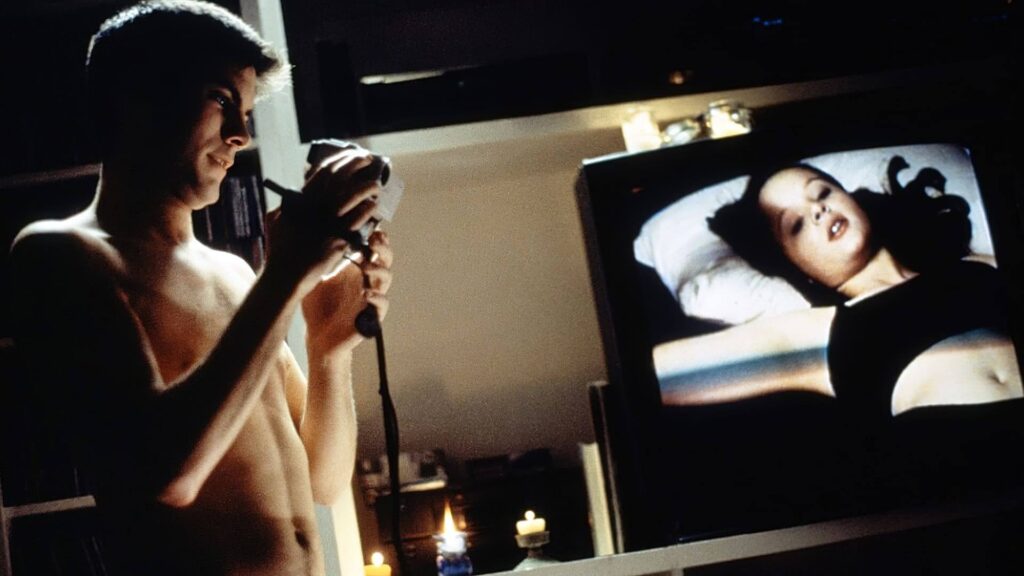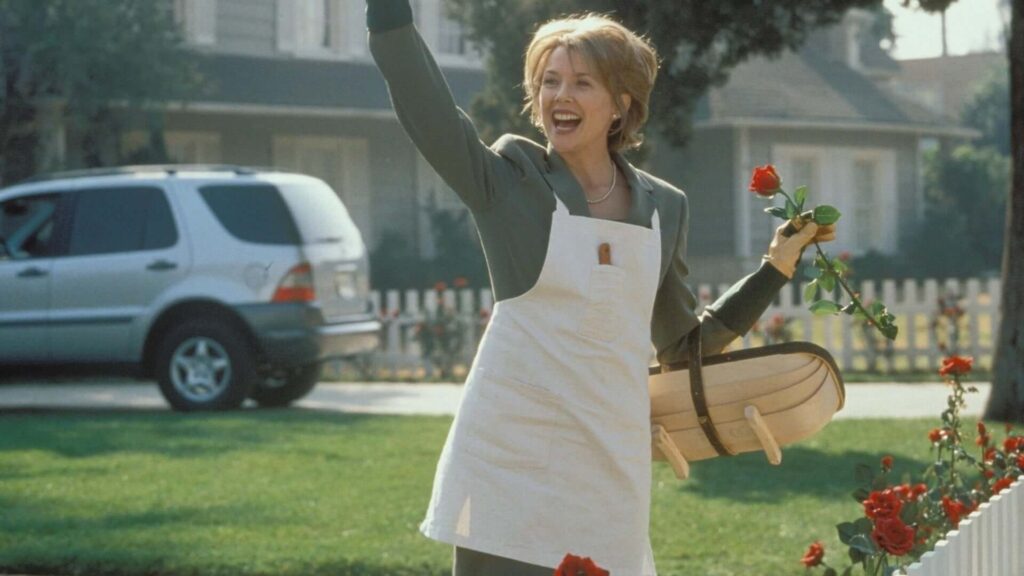American Beauty

1999, R, Drama, 2h, 2m
Table of Contents
What Is American Beauty About?
A sexually frustrated father has a mid-life crisis after becoming infatuated with his daughter’s best friend.
Why You Should Watch American Beauty
American Beauty emerges as an extraordinary cinematic masterpiece, meriting its acclaim and status as a modern classic in film. Its narrative weaves a captivating and insightful story, striking a fine balance between relatability and surprise. This film delves deep into the intricacies of human emotions and relationships, offering a rich tapestry of experiences that resonate profoundly with its audience.

The script, penned by Alan Ball, showcases his remarkable ability to blend sharp wit with a profound understanding of human nature, making the dialogue not only memorable but also incredibly authentic and deep.
The performances in American Beauty are another facet that makes this film a compelling watch. The cast, led by Kevin Spacey, delivers nuanced and exceptional portrayals. Spacey, in his role as Lester Burnham, captures the character’s journey through disillusionment and awakening with a raw and powerful authenticity that is both moving and thought-provoking. Annette Bening’s portrayal of Carolyn Burnham is equally impressive. She brings a nuanced depth to her character, encapsulating the complexities of a woman caught in the web of her own aspirations and dissatisfactions.
The supporting cast, including Thora Birch, Wes Bentley, and Mena Suvari, enrich the film significantly with their dynamic and heartfelt performances, each adding layers to the narrative tapestry.
One of the most commendable aspects of American Beauty is its character development. Each character is intricately crafted, with motivations, desires, and fears that are palpably real and relatable. This depth of character development invites the audience into a deeper level of empathy and understanding, making their journeys and transformations not just observable but deeply felt.
The film excels in peeling back the layers of its characters, revealing the complexities and contradictions that define them, and in doing so, it holds up a mirror to the audience, reflecting the multifaceted nature of human experience.
Sam Mendes’ direction in American Beauty is nothing short of brilliant. He displays a keen eye for detail and a deep understanding of narrative flow. His ability to maintain a seamless balance between moments of drama and dark comedy is exemplary, keeping the audience engaged from the opening scene to the closing credits. His directorial choices, from the pacing to the framing of each scene, demonstrate a masterful grasp of storytelling that elevates the film to a higher level of cinematic excellence.
Furthermore, American Beauty stands out for its exploration of contemporary life and societal norms. It provides a unique window into the lives of its characters, offering a commentary on society that is both insightful and entertaining. The film courageously addresses complex issues, challenging the audience to think and reflect. It explores themes of self-discovery, societal expectations, and the pursuit of happiness in a way that is both profound and accessible.

American Beauty is a film that deserves to be watched and rewatched. Its combination of a compelling narrative, outstanding performances, rich character development, masterful direction, and insightful societal commentary makes it a standout piece of cinematic art. The film is not just a portrayal of characters and events but a deep exploration of the human condition, making it a profoundly impactful and memorable experience for any viewer.
The Theme of American Beauty
American Beauty, directed by Sam Mendes and written by Alan Ball, is a film that delves deeply into the exploration of several complex themes, primarily focusing on the examination of beauty, the dissection of suburban life, and the pursuit of happiness amidst personal turmoil.

The film grapples with the concept of beauty in its many forms. This is most evident in the character of Lester Burnham, who, amidst a midlife crisis, becomes obsessed with his daughter’s friend Angela, symbolizing his yearning for lost youth and beauty.
The film challenges the audience’s perception of beauty, suggesting that it can be found in the most mundane aspects of life, as seen through the eyes of the young neighbor, Ricky Fitts, who finds profound beauty in a plastic bag dancing in the wind. This theme is further explored through the character of Carolyn Burnham, Lester’s wife, whose pursuit of materialistic and superficial beauty contrasts sharply with Lester’s quest for a more authentic, albeit misguided, sense of beauty in his life.
Another prominent theme is the critique of suburban life. American Beauty portrays the suburban setting as a place of hidden despair and hypocrisy, where characters are trapped in unfulfilling roles. The Burnhams and their neighbors, the Fitts, epitomize the hollow existence of suburban life, each family dealing with its own form of dysfunction, whether it be emotional disconnection, repressed sexuality, or abusive relationships. The film exposes the facade of the American Dream as it manifests in suburban America, revealing the loneliness, isolation, and dissatisfaction that often lurk beneath the surface of a seemingly perfect community.
The pursuit of happiness is a theme intricately woven throughout the film, with each character representing a different approach to this quest. Lester’s radical transformation, sparked by his infatuation with Angela, is an attempt to reclaim happiness by rebelling against the monotony of his life. Carolyn’s affair with Buddy Kane and her obsession with success and status are her misguided attempts to find fulfillment. Meanwhile, Jane and Ricky’s budding romance offers a more hopeful perspective, suggesting that genuine connection and acceptance might be key to finding true happiness.

American Beauty also touches on themes of identity and self-discovery. The characters struggle with their sense of self, often wearing masks to hide their true feelings and desires. Lester’s journey is particularly emblematic of this struggle as he seeks to rediscover who he is and what he truly wants from life. Similarly, Colonel Fitts’s character grapples with his hidden homosexuality, highlighting the theme of repressed identity and the destructive consequences of living a life in denial.
The Cinematography of American Beauty
The cinematography of American Beauty, crafted by Conrad L. Hall under the direction of Sam Mendes, is a brilliant demonstration of how visual elements can enhance and underscore a film’s thematic content. Hall’s use of color is deeply symbolic, with the sterility of whites and grays in the Burnham’s home contrasting sharply with the passionate, vibrant reds that signify desire and vitality, particularly in the rose petals of Lester’s fantasies. This color symbolism is complemented by the film’s lighting, which oscillates between soft, diffused tones in dream-like sequences and harsher, more realistic lighting in scenes depicting the stark reality of the characters’ lives.

In terms of framing and composition, Hall often employs tight shots to convey a sense of confinement and suffocation, particularly in domestic settings, while scenes involving Ricky, who is more attuned to the world’s beauty, are shot with wider angles, suggesting openness and a broader perspective. The camera movements are generally subtle, with slow pans and tracks drawing viewers into the intimate world of the characters, and the use of different camera angles adds depth to the narrative, with high and low-angle shots depicting vulnerability and dominance, respectively.
Hall also infuses the film with symbolic motifs, such as the American flag representing disillusionment with the American Dream and visual cues like windows, fences, and mirrors to emphasize themes of entrapment, self-examination, and identity struggle.

The cinematography, a mix of classical Hollywood style and contemporary aesthetics, contributes significantly to the storytelling, making the audience active participants in the narrative. Through its deliberate and thoughtful visual design, American Beauty’s cinematography not only enhances the story but also invites viewers to engage with the film’s exploration of beauty, disillusionment, and the facade of suburban life. Conrad L. Hall’s work in American Beauty stands as a testament to the power of cinematography i
The Soundtrack of American Beauty
The soundtrack of American Beauty, composed by Thomas Newman, is an integral component of the film, imbued with haunting and melancholic melodies that underscore its themes of suburban malaise, beauty, and personal turmoil. Newman’s minimalist and introspective style, marked by the use of unconventional instruments like the marimba and percussion along with the piano, creates a unique and eerie yet beautiful auditory experience. This approach harmonizes with the film’s narrative, emphasizing the internal struggles of the characters and the unsettling atmosphere of their suburban environment.
The score’s integration with the film’s visual elements is masterful, with music playing during pivotal scenes to underscore emotional and thematic undertones rather than overpowering them. For instance, in moments of revelation or introspection, the music swells to highlight these significant turning points, effectively establishing the contemplative and sometimes melancholic mood of the film. This mood invites viewers to reflect on deeper themes, such as the search for beauty and meaning in an ordinary world, and the score’s ability to evoke a range of emotions significantly contributes to the narrative’s impact.
In addition to Newman’s original compositions, American Beauty features several popular songs that further enhance the film’s atmosphere. These include:
- Because” by The Beatles: Played in a scene with Ricky and Jane, this song complements the film’s themes of beauty and simplicity.
- “Open The Door” by Betty Carter: This song is used in a scene that underscores the growing emotional distance between the Burnham couple.
- “We Haven’t Turned Around” by Gomez: Featured in a montage, the song echoes the film’s sentiment about the characters’ internal and relational transformations.
- “Cancer for the Cure” by Eels: Played during a party scene, this song adds to the film’s critique of suburban life and its hidden dysfunctions.
- “Bali Ha’i” from the musical “South Pacific”: This song is used ironically, contrasting its romantic, escapist lyrics with the stark reality of the characters’ lives.
Listen to the original motion picture soundtrack below.
The Cast of American Beauty
- Kevin Spacey as Lester Burnham: Lester, the protagonist, is a middle-aged magazine executive who becomes disillusioned with his mundane life and undergoes a dramatic personal awakening.
- Annette Bening as Carolyn Burnham: Carolyn is Lester’s materialistic and ambitious wife, who is preoccupied with her real estate career and outward appearances.
- Thora Birch as Jane Burnham: Jane is Lester and Carolyn’s insecure teenage daughter, who is struggling with self-image issues and becomes romantically involved with the mysterious new neighbor, Ricky.
- Mena Suvari as Angela Hayes: Angela, a friend of Jane, is an attention-seeking and flirtatious high school cheerleader. She becomes the object of Lester’s fantasies, symbolizing his yearning for youth and vitality.
- Wes Bentley as Ricky Fitts: Ricky, the son of the Burnhams’ new neighbors, is an introspective and philosophical teenager. He is fascinated with beauty in everyday life and develops a deep connection with Jane. He also is a great supporting cast member in Interstellar.
- Chris Cooper as Colonel Frank Fitts, USMC: Colonel Fitts, Ricky’s father, is a strict and controlling ex-Marine who struggles with his own inner demons and prejudices.
- Allison Janney as Barbara Fitts: Barbara, Colonel Fitts’ wife, is a quiet, withdrawn woman largely ignored by her husband and son, reflecting the emotional emptiness in their household.
- Peter Gallagher as Buddy Kane: Buddy Kane, known as the “Real Estate King,” engages in an affair with Carolyn, further complicating the Burnhams’ troubled marriage.
- Scott Bakula as Jim Olmeyer: Jim is one of the Burnhams’ neighbors, a gay man in a stable relationship, representing an alternative, more contented version of suburban life.
- Sam Robards as Jim Berkley: Jim Berkley is Jim Olmeyer’s partner, together depicting a harmonious and contrastingly happier suburban couple.
The Filmmakers of American Beauty
- Sam Mendes (Director): Sam Mendes, in his directorial debut with this film, received critical acclaim for his work, showcasing a unique storytelling style and visual flair.
- Alan Ball (Screenwriter): Alan Ball wrote the screenplay for American Beauty. His script, known for its sharp wit and deep insight into suburban malaise, won an Academy Award for Best Original Screenplay.
- Bruce Cohen and Dan Jinks (Producers): The film was produced by Bruce Cohen and Dan Jinks. Their collaboration brought the project to fruition, earning them an Academy Award for Best Picture.
- Thomas Newman (Composer): Thomas Newman composed the film’s score, which is noted for its distinctive and haunting melodies, contributing significantly to the film’s atmospheric tone.
- Conrad L. Hall (Cinematographer): The late Conrad L. Hall served as the cinematographer for American Beauty. His work on the film is celebrated for its artistic use of color and light, which played a critical role in setting the mood and themes of the movie. Hall won an Academy Award for Best Cinematography for his work on the film.
- Tariq Anwar and Christopher Greenbury (Editors): The film was edited by Tariq Anwar and Christopher Greenbury, whose contributions were essential in crafting the film’s distinctive pacing and narrative structure.

Asparagus Risotto

Inspiration
“Can Someone Please Pass The Fucking Asparagus?” – Lester Burnham

More About American Beauty
American Beauty was primarily filmed in the state of California, USA. The suburban setting, which is a central aspect of the film’s backdrop, was mainly shot in areas around Los Angeles. Here are some specific filming locations:
Burnham House: The home of the main characters, Lester and Carolyn Burnham, was located in the city of Torrance. The actual house used for filming is situated at 11388 Homedale Street.
High School Scenes: The high school scenes were filmed at South High School, also in Torrance, California.
Ricky Fitts’ House: The house of the character Ricky Fitts, played by Wes Bentley, is located across the street from the Burnham house, also in Torrance.
Other Locations: Various other scenes were shot in and around the Los Angeles area, utilizing the region’s suburban landscapes to mirror the film’s thematic focus on suburban American life.
These locations provided the quintessential American suburban backdrop that was integral to the thematic and visual elements of American Beauty. The choice of real suburban houses and local schools added to the film’s authentic depiction of suburban life.
The roses in American Beauty carry significant symbolic meaning, deeply intertwined with the film’s exploration of themes such as desire, beauty, and the illusion of perfection.

Desire and Obsession: The most direct symbolism of the roses is related to Lester Burnham’s infatuation and sexual desire. The rose petals famously appear in his fantasies about Angela, his daughter’s friend. They are often shown covering her naked body, symbolizing both Lester’s lustful desires and the objectification of Angela as an idealized form of beauty and youth.
Illusion of Perfection: Roses are traditionally associated with beauty and perfection, but they also have thorns, which can be seen as a metaphor for the hidden pains and complexities beneath the surface of a seemingly perfect suburban life. In the film, the roses are used in the Burnham household to project a facade of an ideal family and home life, masking the underlying dissatisfaction, unhappiness, and dysfunction.
Artificiality and Superficiality: Carolyn Burnham, Lester’s wife, is often shown tending to her rose garden, which reflects her obsession with appearances and surface-level beauty. The roses here symbolize her desire to maintain an outward appearance of control and perfection, despite the chaos and unhappiness in her personal and family life.
Beauty in the Mundane: The film, through its title and various visual cues, suggests that there is beauty to be found in everyday life, often in simple or overlooked places. The roses, while traditionally beautiful, are also commonplace and can be seen as a reminder to look for beauty in the ordinary and not just in idealized, unattainable forms.
Transience of Life: Roses, like all flowers, are ephemeral, blooming beautifully but eventually wilting and dying. This can be seen as a metaphor for the transient nature of life, youth, and beauty, themes that are central to Lester’s character arc as he confronts his midlife crisis and seeks to recapture his lost youth.
The roses in American Beauty are a multifaceted symbol, rich in meaning and integral to the film’s exploration of desire, the pursuit of superficial beauty, and the contradictions of suburban life. They encapsulate the central themes of the film, serving as a visual motif that enhances the narrative and deepens the audience’s understanding of the characters and their experiences.

